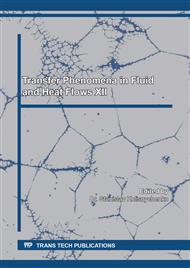[1]
B. Sahin and A. Demir, Thermal performance analysis and optimum design parameters of heat exchanger having perforated pin fins,, Energy conversion and management, vol. 49, pp.1684-1695, (2008).
DOI: 10.1016/j.enconman.2007.11.002
Google Scholar
[2]
A. Baslem, G. Sowmya, B. Gireesha, B. Prasannakumara, M. Rahimi-Gorji, and N.M. Hoang, Analysis of thermal behavior of a porous fin fully wetted with nanofluids: convection and radiation,, Journal of Molecular Liquids, p.112920, (2020).
DOI: 10.1016/j.molliq.2020.112920
Google Scholar
[3]
G. Sowmya, B. Gireesha, S. Sindhu, and B. Prasannakumara, Investigation of Ti6Al4V and AA7075 alloy embedded nanofluid flow over longitudinal porous fin in the presence of internal heat generation and convective condition,, Communications in Theoretical Physics, vol. 72, p.025004, (2020).
DOI: 10.1088/1572-9494/ab6904
Google Scholar
[4]
G. Sowmya, B. Gireesha, and B. Prasannakumara, Scrutinization of different shaped nanoparticle of molybdenum disulfide suspended nanofluid flow over a radial porous fin,, International Journal of Numerical Methods for Heat & Fluid Flow, (2019).
DOI: 10.1108/hff-08-2019-0622
Google Scholar
[5]
J. Lee and I. Mudawar, Fluid flow and heat transfer characteristics of low temperature two-phase micro-channel heat sinks–Part 1: Experimental methods and flow visualization results,, International Journal of Heat and Mass Transfer, vol. 51, pp.4315-4326, (2008).
DOI: 10.1016/j.ijheatmasstransfer.2008.02.012
Google Scholar
[6]
B. Agostini, J.R. Thome, M. Fabbri, B. Michel, D. Calmi, and U. Kloter, High heat flux flow boiling in silicon multi-microchannels–Part II: Heat transfer characteristics of refrigerant R245fa,, International Journal of Heat and Mass Transfer, vol. 51, pp.5415-5425, (2008).
DOI: 10.1016/j.ijheatmasstransfer.2008.03.007
Google Scholar
[7]
A. Aziz and M. Bouaziz, A least squares method for a longitudinal fin with temperature dependent internal heat generation and thermal conductivity,, Energy conversion and management, vol. 52, pp.2876-2882, (2011).
DOI: 10.1016/j.enconman.2011.04.003
Google Scholar
[8]
H. Jouhara and B.P. Axcell, Modelling and simulation techniques for forced convection heat transfer in heat sinks with rectangular fins,, Simulation Modelling Practice and Theory, vol. 17, pp.871-882, (2009).
DOI: 10.1016/j.simpat.2009.02.007
Google Scholar
[9]
X. Zhang and D. Liu, Optimum geometric arrangement of vertical rectangular fin arrays in natural convection,, Energy conversion and management, vol. 51, pp.2449-2456, (2010).
DOI: 10.1016/j.enconman.2010.05.009
Google Scholar
[10]
F. Khani and A. Aziz, Thermal analysis of a longitudinal trapezoidal fin with temperature-dependent thermal conductivity and heat transfer coefficient,, Communications in Nonlinear Science and Numerical Simulation, vol. 15, pp.590-601, (2010).
DOI: 10.1016/j.cnsns.2009.04.028
Google Scholar
[11]
B. Taufiq, H.H. Masjuki, T. Mahlia, R. Saidur, M. Faizul, and E.N. Mohamad, Second law analysis for optimal thermal design of radial fin geometry by convection,, Applied Thermal Engineering, vol. 27, pp.1363-1370, (2007).
DOI: 10.1016/j.applthermaleng.2006.10.024
Google Scholar
[12]
N. Fallo, R.J. Moitsheki, and O.D. Makinde, Analysis of Heat Transfer in a Cylindrical Spine Fin with Variable Thermal Properties,, in Defect and Diffusion Forum, 2018, pp.10-22.
DOI: 10.4028/www.scientific.net/ddf.387.10
Google Scholar
[13]
P.L. Ndlovu and R.J. Moitsheki, Predicting the Temperature Distribution in Longitudinal Fins of Various Profiles with Power Law Thermal Properties Using the Variational Iteration Method,, in Defect and Diffusion Forum, 2018, pp.403-416.
DOI: 10.4028/www.scientific.net/ddf.387.403
Google Scholar
[14]
G.G. Botte, J.A. Ritter, and R.E. White, Comparison of finite difference and control volume methods for solving differential equations,, Computers & Chemical Engineering, vol. 24, pp.2633-2654, (2000).
DOI: 10.1016/s0098-1354(00)00619-0
Google Scholar
[15]
B. Leonard, Comparison of truncation error of finite-difference and finite-volume formulations of convection terms,, Applied Mathematical Modelling, vol. 18, pp.46-50, (1994).
DOI: 10.1016/0307-904x(94)90182-1
Google Scholar
[16]
J. Newman, Numerical Solution Of Coupled, Ordinary Differential Equations,, (1967).
Google Scholar
[17]
J. Newman, Numerical solution of coupled, ordinary differential equations,, Industrial & Engineering Chemistry Fundamentals, vol. 7, pp.514-517, (1968).
DOI: 10.1021/i160027a025
Google Scholar
[18]
S. Patankar, Numerical Heat Transfer and Fluid Flow: CRC Press,, (1980).
Google Scholar
[19]
C.-H. Chiu and C. o.-K. Chen, Application of Adomian's decomposition procedure to the analysis of convective-radiative fins,, Journal of Heat transfer, vol. 125, pp.312-316, (2003).
DOI: 10.1115/1.1532012
Google Scholar
[20]
D. Mueller Jr and H.I. Abu-Mulaweh, Prediction of the temperature in a fin cooled by natural convection and radiation,, Applied Thermal Engineering, vol. 26, pp.1662-1668, (2006).
DOI: 10.1016/j.applthermaleng.2005.11.014
Google Scholar
[21]
L. Huang and R. Shah, Assessment of calculation methods for efficiency of straight fins of rectangular profile,, International journal of heat and fluid flow, vol. 13, pp.282-293, (1992).
DOI: 10.1016/0142-727x(92)90042-8
Google Scholar
[22]
E. Sparrow and E. Niewerth, Radiating, convecting and conducting fins: Numerical and linearized solutions,, International Journal of Heat and Mass Transfer, vol. 11, pp.377-379, (1968).
DOI: 10.1016/0017-9310(68)90170-1
Google Scholar
[23]
C.-H. Chiu, A decomposition method for solving the convective longitudinal fins with variable thermal conductivity,, International Journal of Heat and Mass Transfer, vol. 45, pp.2067-2075, (2002).
DOI: 10.1016/s0017-9310(01)00286-1
Google Scholar
[24]
G.M. Sobamowo, B.Y. Ogunmola, and G. Nzebuka, Finite volume method for analysis of convective longitudinal fin with temperature-dependent thermal conductivity and internal heat generation,, in Defect and Diffusion Forum, 2017, pp.106-120.
DOI: 10.4028/www.scientific.net/ddf.374.106
Google Scholar
[25]
E. Madenci and I. Guven, The finite element method and applications in engineering using ANSYS®: Springer, (2015).
DOI: 10.1007/978-1-4899-7550-8
Google Scholar


